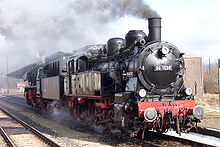Plaue–Themar railway
The Plaue–Themar railway is a 62 kilometre-long, single-track, non-electrified, standard-gauge branch-line in the Thuringian Forest (Thüringer Wald) in Germany.Under this option, an approximately 2000 m-long tunnel would have been built under the ridge of the Thuringian Forest in the Schmücke/Großer Finsterberg area.[2] When the Thuringian Railway Company (Thüringische Eisenbahn-Gesellschaft) proposed in 1876 to continue the line from Arnstadt to Ilmenau, difficult negotiations had to be held with the representatives of the various states.The citizens feared that constant boiler explosions would ravage the country, that the smoke of the locomotives would pollute the air and make the grass bitter and that the cows would give only sour milk as a result of the sight of the monsters—common prejudices in the time, which George Stephenson also had to fight in England.The Duke's consent was dependent on a large and prestigious station in Elgersburg, which would include permanent additional tracks that would be available for the use of his special trains.The new complex route also avoided touching the area of the municipality of Geschwenda, whose citizens were vehement against the building of a railway.In fact, Martinroda and Geraberg (at that time still called Gera ) provided virtually all the land for the line free of charge.In Angelroda support for the 26 m high embankment on the edge of the village, which was now necessary, was anything but enthusiastic, as it was feared that there would be less "good air" coming down from the Thuringian Forest in down-slope winds.This requirement meant that all viaducts, mountain sections and bridges had to be built significantly larger than originally planned.[5] Tree clearing began in the winter of 1877/78 and the groundbreaking ceremony was held on 23 April 1878 at Kleine Spiegelsberg, between Roda and Elgersburg.The most outstanding achievements were the rock cutting on the approach through a hill to the bridge in Angelroda, which was up to 26 m deep, and the movement of earth for an embankment near Plaue, which was 825 m long and up to 8.5 m high.The original steel lattice structures of the two piers were covered in concrete in 1905 to increase their load bearing capacity.In contrast to the steel pillars, the rebuilt concrete bridge piers were again designed to receive the superstructures for a second track that was never installed.The planned continuation from Grossbreitenbach to Schönbrunn (in the municipality of Schleusegrund) or Katzhütte (which the Schwarza Valley Railway reached from Rudolstadt on 18 August 1900) was omitted.Here, in particular, a 7 km-long connection to Katzhütte would have significantly increased traffic on the line, but it failed because of the difficult geology on this route.Citizens of Angelroda, who feared damage to their houses, some of which were next to the bridge, delayed the detonation until the arrival of American troops.The renovation of the section between Elgersburg and Ilmenau, which had originally been planned to be done separately was, however, brought forward and was also intended to be completed by May 2013.Since the timetable change in June 2014, Erfurter Bahn services have run on weekends and holidays to Rennsteig station.Since East Germans initially found it difficult to travel to many more distant destinations and later were not able to reach them at all, tourism in the Thuringian Forest had its heyday.After the end of communism in the GDR, express trains still ran on this secondary railway from Themar to Erfurt and in the opposite direction.[19] Erfurter Bahn was to start operations on the line by extending the Erfurt–Ilmenau service to Rennsteig station every two hours on Sundays and public holidays from 15 June 2014.The newspaper Freies Wort presumed personal animosities between Enders and Carius during the upcoming parliamentary elections was the real reason for the refusal of the proposal which had previously been supported.[20] On 10 June 2014, Carius, however, ultimately approved the contract for its operation and Enders announced the adjustment of bus route 300 from September 2014.This procedure ensured that the boiler water on the steep rack sections always stood at a sufficient height above the ceiling of the firebox.On 24 March 2007, the 612 176 set first ran the line as a non-public special train to prove its suitability for Rennsteigbahn.The Federal Railway Authority (Eisenbahn-Bundesamt) finally granted approval for the operation of Erfurter Bahn's Regio-Shuttles on the steep grades without additional modifications on 24 January 2014 after it had been drafting a new set of rules for several years.This gave Schleusingen a long-awaited connection to the railway network, thereby giving an important stimulus to the economy and making possible a revitalisation of the Rennsteig region around Schmiedefeld.A class 52 steam locomotive of the IGE Werrabahn Eisenach e. V. was regularly used for this timber traffic in March and April 2006.Rennsteigbahn GmbH & Co KG is a private train operating and infrastructure owning company based in Schmiedefeld am Rennsteig, which is responsible for the Ilmenau–Themar and Schleusingen–Suhl lines.The company organises excursions, together with Dampfbahnfreunden mittlerer Rennsteig e. V., on the Ilmenau–Rennsteig station–Themar Nostalgiefahrten route on several weekends a year and operates freight traffic (including timber transport and waste shipments from Ilmenau to the incinerator in Leuna).











ThuringiaTrack gaugestandard gaugeElectrification15 kV/16.7 HzcatenaryMaximum inclinefrom Erfurtto SchweinfurtMartinrodaGerabergElgersburgIlmenauStützerbachrack sectionSchmiedefeld am RennsteigSchleusingenKloster Veßrafrom EisfeldThemarto Meiningenstandard-gaugebranch-lineThuringian ForestPrussianrack railwayErfurt–Schweinfurt railwayEisenach–Lichtenfels railwayErfurter BahnPlaue stationZahme GeraAngelrodaviaductcuttingReichenbach valleyGera valleyIlm valleyIlmenau stationNeudietendorf–Arnstadt railwayArnstadtSaalfeldThuringian Railway CompanySaxe-Coburg and GothaErnst IIGeschwendaOhrdrufboiler explosionsGeorge Stephensondown-slope windsSchwarzburg-RudolstadtGehrenSchwarzburgRudolstadtGera–Saalfeld–Eichicht railwaymain line from PlaueOberhofWürzburgSaxe-Weimar-EisenachSchwarzburg-SondershausengroundbreakingDay labourersfield railwayfuniculardynamiteblack powderKönigseeStadtilmWeimarGroßbreitenbachSchleusegrundKatzhütteCold WarsabotageLockheed P-38 LightningStadler Regio-Shuttle RS1Bombardier ItinoKickelhahnlinear settlementBundesstraße 4hairpin turnsLengwitzRennsteigzig zagNahe valleyfoothillsErle valleyPrussiaend of communism in the GDRclass 94.5–17Mitteldeutscher RundfunkLandratChristian CariusFreies Wortadhesion railwaysrack and pinionPrussian state railwaysclass 95Riggenbach counter-pressure brakesair brakesclass 612Regio-ShuttleFederal Railway AuthorityLVT class 771Süd-Thüringen-BahnSchweinfurtclass 52Deutsche Bahn

